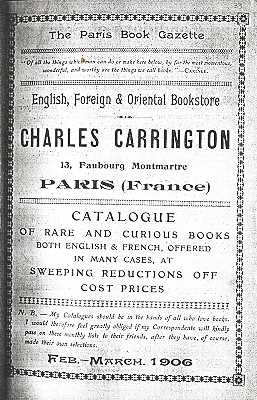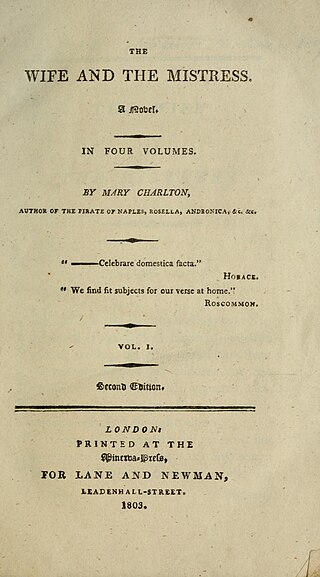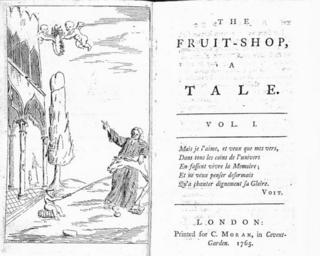Related Research Articles
Courtesan, in modern usage, is a euphemism for a kept mistress or prostitute, particularly one with wealthy, powerful, or influential clients. The term historically referred to a courtier, a person who attended the court of a monarch or other powerful person.

Mary Anne Clarke was the mistress of Prince Frederick, Duke of York and Albany. Their relationship began in 1803, while he was Commander-in-Chief of the army. Later in 1809, she wrote her memoirs which were published. She was the subject of a portrait by Adam Buck, and a caricature by Isaac Cruikshank; ten days after the latter's publication, the Duke resigned from his post as Commander of the British Army. In 1811, she commissioned Irish sculptor Lawrence Gahagan to sculpt a marble bust of her; this is now housed in the National Portrait Gallery, London.
The role of sadism and masochism in fiction has attracted serious scholarly attention. Anthony Storr has commented that the volume of sadomasochist pornography shows that sadomasochistic interest is widespread in Western society; John Kucich has noted the importance of masochism in late-19th-century British colonial fiction. This article presents appearances of sadomasochism in literature and works of fiction in the various media.

Erotic literature comprises fictional and factual stories and accounts of eros intended to arouse similar feelings in readers. This contrasts erotica, which focuses more specifically on sexual feelings. Other common elements are satire and social criticism. Much erotic literature features erotic art, illustrating the text.

Henry Spencer Ashbee was a book collector, writer and bibliographer. He is notable for his massive, clandestine three-volume bibliography of erotic literature published under the pseudonym of Pisanus Fraxi.

Grace Dalrymple Elliott was a Scottish courtesan, writer and spy resident in Paris during the French Revolution. She was an eyewitness to events detailed in her memoirs, Journal of my life during the French Revolution published posthumously in 1859. She was mistress to the Duke of Orléans and to the future George IV, by whom she is said to have borne an illegitimate daughter. Elliott trafficked correspondence and hid French aristocrats escaping from the French Revolution. She was arrested several times but managed to avoid the guillotine, and was released after the death of Robespierre.
William Simpson Potter was a 19th-century English author. Potter was a friend of Henry Spencer Ashbee, a merchant, bibliographer, bibliophile, authority on the life and works of Miguel de Cervantes, and collector of erotic materials. Ashbee describes Potter as a "shrewd business man, the ardent collector, and the enthusiastic traveller".

Charles Carrington (1857–1921) was a leading British publisher of erotica in late-19th- and early-20th-century Europe. Born Paul Harry Ferdinando in Bethnal Green, England on 11 November 1867, he moved in 1895 from London to Paris where he published and sold books in the rue Faubourg Montmartre and rue de Chateaudun; for a short period he moved his activities to Brussels. Carrington also published works of classical literature, including the first English translation of Aristophanes' "Comedies," and books by famous authors such as Oscar Wilde and Anatole France, in order to hide his "undercover" erotica publications under a veil of legitimacy. His books featured the erotic art of Martin van Maële. He published a French series La Flagellation a Travers le Monde mainly on English flagellation, identifying it as an English predilection.

My Secret Life, by "Walter", is the memoir of a gentleman describing the author's sexual development and experiences in Victorian England. It was first published in a private edition of eleven volumes, at the expense of the author, including an imperfect index, which appeared over seven years beginning around 1888.
Thomaso, or the Wanderer is mid-seventeenth-century stage play, a two-part comedy written by Thomas Killigrew, The work was composed in Madrid, c. 1654. Thomaso is based on Killigrew's personal experiences as a Royalist exile during the era of the Commonwealth, when he was abroad continuously from 1647 to 1660.
Edward Sellon (1818–1866) was an English writer, translator, and illustrator of erotic literature.
James Campbell Reddie was a 19th-century collector and author of pornography, who, writing as "James Campbell", worked for the publisher William Dugdale. According to Henry Spencer Ashbee, Reddie was self-taught and viewed his works from a philosophical point of view.
The New Epicurean: The Delights of Sex, Facetiously and Philosophically Considered, in Graphic Letters Addressed to Young Ladies of Quality is a Victorian erotic novel published by William Dugdale in 1865 and attributed to Edward Sellon. The novel is falsely dated "1740", and is written as an eighteenth-century pastiche, composed of a series of letters addressed to various young ladies.
The Library Illustrative of Social Progress was a series of pornographic books published by John Camden Hotten around 1872. They were mainly reprints of eighteenth-century pornographic works on flagellation. Hotten claimed to have found them in the library of Henry Thomas Buckle (1821–1862) but Henry Spencer Ashbee counterclaimed that they were in fact from his collection.
The Victim of Lust, or Scenes in the Life of Rosa Fielding is an anonymously written Victorian pornographic novel published by William Dugdale in 1867.

Justine Paris, real name Bienfait, was a French courtesan and madam. She hosted several of the most famous brothels in mid-18th-century Paris and was one of the most known and successful of her trade. She and her brothel are portrayed in the memoirs of Casanova. She has been suggested to be the role model for the title character in Juliette by the Marquis de Sade.

Mary Charlton, Gothic novelist and translator, was a "leading light" at the Minerva Press.

The Fruit-Shop, a Tale is an anonymous work of satire with erotic themes printed at London by C. Moran in 1765. A second edition was printed in 1766 for J. Harrison, near Covent Garden. The text is, for the most part, an allegorical and discursive disquisition on the "Fruit-Shop", as the author calls woman, or rather on those parts of her which are more particularly connected with fruit-bearing.
The Seducing Cardinal, or, Isabella Peto is an anonymous erotic novel printed at London in 1830. The title page reads: "The Seducing Cardinal, or, Isabella Peto. A Tale founded on Facts. London: Published as the Act directs, By Madame Le Duck, Mortimer Street; and to be had of all Respectable Booksellers. 1830".